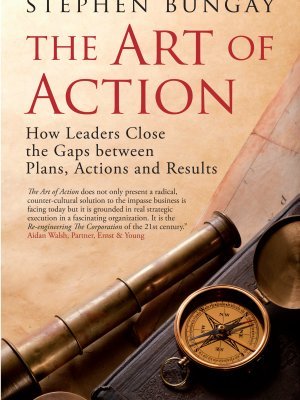Most corporate strategic plans are crafted by well-meaning, highly intelligent, deeply experienced executives, who take great care to tick all the right boxes. Yet the moment such plans make contact with the real world, they crash and burn. Why? Stephen Bungay is an Oxford-educated, former Boston Consulting Group consultant and military historian who answers the question in a 2010 book called The Art of Action. Bungay currently teaches at Britain’s Ashridge Business School.
Rommel - no genius
Stephen Bungay’s investigation began when he started writing a book on the World War II campaign in the Western desert, culminating in the battle of El Alamein[1]. He approached it, he says, “not as most historians do, but as a management consultant. In other words, I saw this not as a clash of nations or of individuals, but as a clash of organisations.”
He looked at the historiography of the period: “One of the features is that people explain the German performance by singling out Rommel as a unique military genius. This to me was extremely implausible. I know the sort of impact that leaders can have on their organisations, but they can’t change organisational behaviour fundamentally overnight when they have 45 000 people under their command. I began to think that there must be other reasons why the German army in North Africa appeared to be able to act very rapidly, adapt to circumstances, show a high level of what we would today in business call agility, and yet remain focused on achieving particular goals. And they were very coherent as well in everything they did.
As he studied the literature, Bungay realised that this was an army that had inherited “what I would call perhaps an organisational operating model, or to use military terms, a method of command and control, i.e. setting direction, making things happen.”
Von Clausewitz & Friktion
He traced the origins of this model back to the early and mid- parts of the 19th Century. In 1806, the Prussian army, as it then was, had taken a terrible beating at the twin battles of Jena and Auerstädt, thrashed by Napoleon and his marshal Davout. This humiliation led to decades of soul-searching and debate by the Prussian High Command in a bid to ensure it was never repeated. A key contribution was made by the young General Carl von Clausewitz who introduced the concept of ‘Friktion’ – literally, friction – in his monumental work ‘On War’, published in 1832, a year after his death.
“At a crude level, you can understand friction as being an account of Murphy’s Law,” explains Bungay, adding “it’s why shit happens and stuff always goes wrong.”
But Clausewitz was a deep thinker and was not describing friction in a cynical way at all, says Bungay: “We experience friction all the time. It’s rooted in the very fundamental and undeniable fact that human beings are limited with respect to two things: one is the amount of knowledge that they have, and the other is the fact that they have independent wills.”
The consequence of this, he says, is that when people get together in an organisation to make something happen, just because one of them wants it to happen doesn’t mean that the others are going to: “The limitations in knowledge are two kinds. There are things that you could know but happen not to, because you don’t have the data. But there are some things that are fundamentally unknowable, fundamental uncertainties about what the future is going to bring.”
Flowing from this, says Bungay, is that “when we take our limited knowledge and transfer it around from one to the other, there is always some level of degradation or loss. When we interpret whatever it is that we’ve understood, we may draw different conclusions from it. And then you can divide down again: the lack of knowledge can be down perhaps to data we don’t have, information we’d like to have but we don’t, but it can also be created by noise which obscures the signal. When we transfer around the message that we want to get across, we can misunderstand the words, we can understand the words but interpret the meaning differently. We can interpret the meaning the same but reach different conclusions about what really matters for us, depending on where we are in the organisation, and we will also have different interests given where we sit in the organisation. So we may actually try to do different things on the basis of what we’ve understood.”
Bungay points out that all of this occurs before we come into contact with the external world: “The outcomes of those actions don’t just depend on what we do, but on how people react to what we do. How our customers actually react to our new product launch. Are they actually going to be as enthusiastic as we think they ought to be? And of course there’s one set of actors out there, namely our competitors, who are actually trying to make our lives difficult, they’re actually trying to make us screw up.”
Put all of this together, says Bungay, “and you begin to understand that the problems of execution are pretty fundamental. When things have gone wrong, they’ve actually gone normal. So I’m suggesting that we should set up organisations that are geared up to a world of friction as a normality, not as a variation. You don’t make a plan and then adjust a bit for risk or uncertainty.”
Von Moltke and Mission Command
Clausewitz died of cholera before the publication of his seminal Vom Kriege (On War) and it was left to a later Prussian General – later Field Marshal – Helmuth von Moltke2 to actually build an organisation capable of routinely dealing with friction. It was Moltke, according to Bungay, “who then developed the culture of the new Prussian Army which emerged from the disaster of Jena and created a new set of practices, the technique for setting direction, cascading it through the organisation, and developing a more rigorous communications technique. That method has been adopted since by almost every army in NATO. It goes under the name Mission Command.”
Moltke’s breakthrough, implemented with devastating effect in the Franco-Prussian War of 1870-71, was to make sure that all his commanders understood the overall context shaping action and the broad objectives of his strategy. To this effect, he only ever issued directives, never detailed orders, and officers in the field were left alone to make appropriate decisions based on rapidly changing circumstances, but always with the end goals in mind.
“It seemed to me that this approach would be a solution to problems that I saw almost all of my clients struggling with when trying to turn strategy into action,” says Bungay, remembering his thoughts of more than ten years ago. “It’s scalable, it’s transferrable, because other armies have adopted it…okay, maybe it’s got something to do with German culture, but I didn’t really think so. A lot of our guys do it these days, although the British army didn’t do it in the desert in WW II. Why couldn’t it be used in business?”
He began to apply the techniques with clients, some large and some small. To his delight, they worked, although he spent a long time in his role as a consultant double-checking “with different kinds of organisations, different nationalities, different business sectors”. From this work came his book The Art of Action.
Intelligent organisations
Bungay credits Moltke with creating the “intelligent organisation”.
“One of my laws of organisations is that the intelligence of an organisation is never equal to the sum of the intelligence of the people inside it. In fact, some of the most stupid organisations I’ve come across have contained some of the cleverest people. These organisations systematically deprive themselves of the use of the intelligence of these people by over-controlling them and giving them thousands of standard operating procedures. It’s not about more control, it’s actually about more empowerment, giving people clear outcomes to achieve.”
It starts, he explains, with “high level intent – what we have to achieve and why.” That’s couched in context: “what’s going on in the world and inside the organisation.” The executive (or officer) is then asked to think about what his or her contribution should be, “and then specify the tasks that are implied by achieving that for your next level down.”
Boundary conditions are set, which have to be observed: “For example, maximise sales but do not allow margin to fall below a net 4%. Or go for growth but on no account are you to compromise safety. Safety comes first, if in doubt.” Then the executive is told to “go away, have a think, come back and we’ll have another discussion where you tell me what you’re going to do as a result. So I give you a briefing, and we complete that with a back briefing when you brief me back. So communication becomes a loop and I stop telling and telling and telling and do some listening.”
Bungay observes wryly that a recent CEO appointment had been reminded “that they’d been given two ears and one mouth and that they should use them in that proportion.” This means that “the leader has to listen to the next leader down, and so on, checking that they’ve understood. Only when that loop has been completed can we go. What you then have are intelligent middle and junior ranks, who are not just allowed but expected to have thought hard about what makes sense, and to continue to observe and assess the situation as it develops, and if necessary change what they do in order to realise the intention.”
The Prussians under Moltke “thought very hard about what this kind of behaviour from their middle leadership ranks meant. They coined the phrase and defined discipline as ‘independent thinking obedience’. It’s a form of obedience because you must act in line with the higher intent. It’s independent because you don’t wait to be told what to do, because speed matters. And it’s thinking because you’re expected to exercise your own judgment about what the right thing to do is. As a result of this, we’re replacing central control with a high-level direction and accountability for contributing to achieving that direction all the way down.”
One side effect, notes Bungay, is that some people will enjoy this style of leadership and flourish: “Most people will accept it and their performance will go up generally if they’re treated like that. But a few people will be scared out of their wits because they want to be told exactly what to do and how to do it. Then they can’t be blamed if anything goes wrong. You get a few of them around. So there are limits to the extent to which you can push this down through organisations, but in general I find most people respond positively.”
It’s a method that also takes a very special kind of leader at the top, who in the military world is not called the ‘leader’ but the ‘commander’. The job of the commander is not to lead from the front, but to work out a strategy, set direction and make critical decisions. It’s the type Jim Collins, in ‘Good to Great’, called a ‘level 5 leader’. Bungay recounts how, on the eve of war with France, a staff officer found Moltke in his office, lounging on a sofa, reading a novel. “He replied, “Well everybody knows how to get the troops to the frontier. But in two days time, I’m going to have to make some tough decisions. I need a clear mind, so I’m relaxing!” There’s an almost superhuman self-control and discipline about this – and self confidence!”
[1] Alamein, Stephen Bungay, 2002
[2] Known as 'The Elder' to distinguish him from his younger and less competent nephew of the same name.







